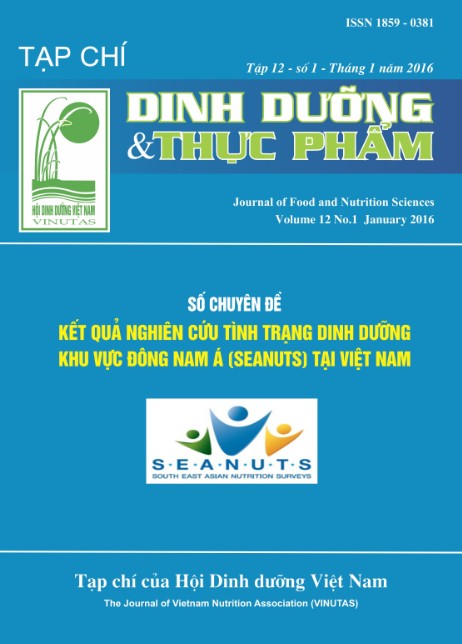PREVALENCE OF VITAMIN D DEFICIENCY AMONG PRIMARY SCHOOL CHILDREN IN 2012
Main Article Content
Abstract
A cross-sectional study has been conducted in 388 aged 6-11 to determine the prevalence of vitamin D deficiency among primary school children in 6 provinces across Vietnam. For each individual, data concerning daily diet, socioeconomic group, and anthropometric status were obtained, and plasma concentrations of vitamin D were measured. Serum 25(OH) vitamin D was measured by HPLC method. Results: The prevalence of hypovitaminosis D status was very high, with the prevalence of vitamin D deficiency (25(OH)D <30 nmol/L) being 19.0%. The prevalence of vitamin D insufficiency (25(OH)D between 30 – 49.9 nmol/L) and marginal vitamin D deficiency (25(OH)D between 50 – 74.9 nmol/L) in primary school children were 30.2% and 77,8%, respectively. There was a positive correlation between vitamin D concentration and serum retinol in school-aged children (Pearson correlation coefficient r = 19.9; p <0.001). Low vitamin D intake children had 43% increased risk (OR = 0.57, [0,36 ; 0,91]) for vitamin D insufficiency (25(OH)D <50 nmol/L) (p<0.028). Conclusions: Vitamin D deficiency and insufficiency are common among urban and rural primary school children. The prevention of micronutrient deficiencies including vitamin D deficiency should be promoted by appropriate interventions to improve the micronutrient status for children in the future.
Keywords
Vitamin D deficiency, insufficiency (25(OH)D, school chidren, uban, rural
Article Details
References
2. Wagner CL and Greer FR (2008). Prevention of rickets and vitamin D deficiency in infants, children, and
adolescents. Pediatrics. 122(5), pp. 1142-52.
3. Institute Of Medecine (2010). Updates Guidance on Vitamin D, Calcium. IOM. http://www.aafp.org/online/en/home/publications/news/news-now/healthof-thepublic/20101201iomrpt vitdcal.html. Accessed 2013 March 15.
4. Bischoff-Ferrari HA, Willett WC, Wong JB, Stuck AE, Staehelin HB, et al. (2009) Prevention of nonvertebral fractures with oral vitamin D and dose dependency: a meta-analysis of randomized controlled trials. Arch Intern Med 169: 551–561.
5. Laillou A, Wieringa F, Tran TN, Van PT, Le BM, et al. (2013) Hypovitaminosis D and Mild Hypocalcaemia Are Highly Prevalent among Young Vietnamese Children and Women and Related to Low Dietary Intake. PLoS ONE 8(5): e63979. doi:10.1371/journal.pone.0063979
6. Geok L Khor et al. (2011). High prevalence of vitamin D insufficiency and its association with BMI-for-age among primary school children in Kuala Lumpur, Malaysia. BMC Public Health. 11(95).
7. Le Nguyen Bao Khanh et al. (2013). Double burden of undernutrition and overnutrition in Vietnam in 2011: results of the SEANUTS study in 0.5–11-year-old children. British Journal of Nutrition. 110, pp. 45- 56.
8. Taha SA, Dost SM and Sedrani SH (1984). 25-Hydroxyvitamin D and total calcium: extraordinarily low plasma concentrations in Saudi mothers and their neonates. Pediatr Res. 18, pp. 739-41.
9. Nguyễn Xuân Ninh và các cộng sự. (2014). Hiệu quả của bánh bích quy có bổ sung Ergostrerol giàu vitamin D2 đến tình trạng dinh dưỡng và một số chỉ tiêu hóa sinh trên học sinh tiểu học. Tạp chí Dinh dưỡng và Thực Phẩm. 10(4), tr.132-140.


